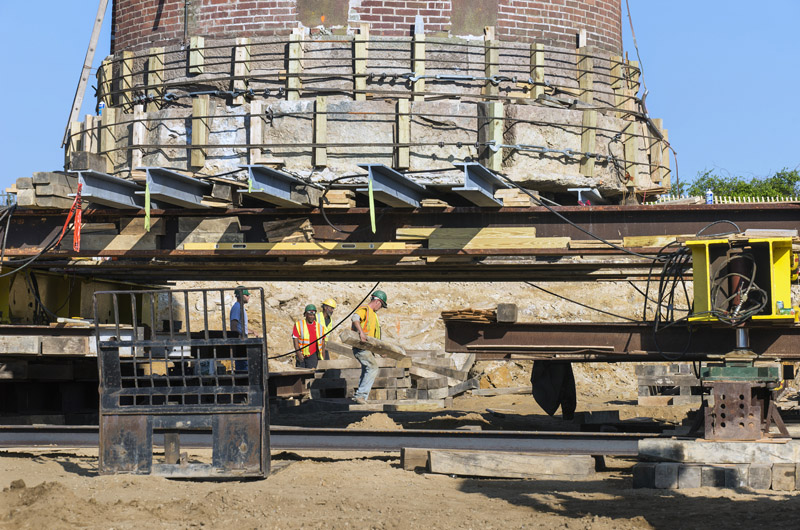Working at an accelerated pace, crews moving the Gay Head Light now expect to finish the job by Saturday morning.
The lighthouse move began Thursday morning with much fanfare, attended by members of the press on the ground and in the air, filmmakers and a group of school children from Chilmark.
By late in the day the 1856 brick tower had been traveled 52 feet of the 129-foot journey that will end on a new concrete pad well to the east of the eroding cliffs.
By Friday afternoon under a cloudless sky, International Chimney and Expert House Movers, the two main contractors for the move, had moved the lighthouse nearly to the pad. At first the plan called for working until nightfall to finish the job, but then it was decided that work will begin again very early Saturday morning.
Earlier on Friday morning, day two of the move, a handful of onlookers gathered to watch the progress. Movers prepared two massive steel travel beams in front of the lighthouse, which now sits near the center of a large excavation. More people arrived throughout the morning with cameras in hand. Resident swallows came and went from their nest inside a metal drainpipe near the top of the lighthouse.

At around 11:15 a.m., the gas generator that powers a pneumatic pump connected to two large hydraulic jacks started up and the lighthouse was again moving. By noon it had covered another 11 feet. The new concrete pad had been fenced off as a safe zone for visitors. But by afternoon on Friday, with the lighthouse approaching, the metal barriers were removed and visitors were kept to one side. A formal viewing period for the public is scheduled for Saturday from 8:30 a.m. to 4:30 p.m.
Len Butler, chairman of the town lighthouse relocation committee, said there had been some settling under the lighthouse yesterday, causing the structure to tip imperceptibly to one side. But the special hydraulic system was quickly adjusted to make up for the difference. “It was a little pocket of clay or something that they went over that was softer,” Mr. Butler said.
He noted that the 400-ton lighthouse, and the 100-ton assembly of steel beams and oak blocks on which it rests, had thoroughly flattened a penny that Jerry Matyiko, owner of Expert House Movers, had placed on one of the travel beams.
Mr. Butler, along with lightkeeper Richard Skidmore, hosted a group of fifth and sixth graders from the Martha’s Vineyard Charter School, who leaned against the metal barriers and asked questions as work continued around the site.
Mr. Skidmore pointed toward a large truck parked beside the lighthouse. “You’ll know when it’s moving when that yellow truck starts to make noise over there,” he said. “That means the hydraulic pressure is being brought up to a level that can push the lighthouse along.” Several black hoses ran from the truck to the 16 hydraulic jacks beneath the lighthouse and the two larger jacks that provide forward motion.
Mr. Butler explained that the lighthouse travels along the beams at about one inch per minute, in increments of about five-feet. “It’s a bunch of little pushes,” he said. “They did that 10 times yesterday so they moved it a little over 50 feet.”
Mr. Skidmore noted that a combination of ancient and modern technology was used for the move, including traditional plumb bobs and levels. “These are basic tools that they’ve used for thousands of years,” he said. In fact none of the technology needed for the move is electronic. The hydraulics are pneumatically powered with a gas generator.
Students passed around a tiny surveyor’s stake that likely marked the exact center of the 1856 location. Several of the stakes had been discovered during the excavation, and had been preserved by the clay.
Mr. Matyiko, who sat nearby in a small bull dozer, suggested that the students sign a piece of paper that will be buried underneath the lighthouse in its new location. One by one, the students wrote their names with a black marker as Matt Kwiecisnki of CBS filmed over their shoulders.
Describing a stable backbone of clay that runs underneath the lighthouse, Mr. Butler said the new location was expected to be safe from erosion for at least 150 years.









Comments (4)
Comments
Comment policy »